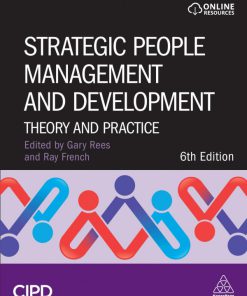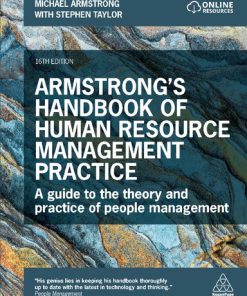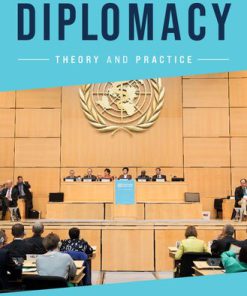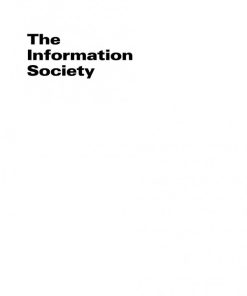The Theory and Practice of Change Management 6th Edition by John Hayes ISBN 9781352012552 1352012553
$50.00 Original price was: $50.00.$25.00Current price is: $25.00.
The Theory and Practice of Change Management 6th Edition by John Hayes – Ebook PDF Instant Download/Delivery: 9781352012552 ,1352012553
Full download The Theory and Practice of Change Management 6th Edition after payment

Product details:
ISBN 10: 1352012553
ISBN 13: 9781352012552
Author: John Hayes
The Theory and Practice of Change Management 6th Edition Table of contents:
- KEY CHANGES TO THE SIXTH EDITION
- Revised structure and new chapter
- Diagnosis
- Responding to pervasive big-bang disruptions such as the COVID-19 pandemic
- Family businesses
- Destructive leadership
- Promoting responsible behaviour and ethical change management
- Learning objectives
- References
- New case studies and examples
- PATHWAYS
- The ‘essentials’
- Recognizing the need for change
- Diagnosis
- Implementing change
- Other ways to access content relevant to your needs
- ACKNOWLEDGMENTS
- TOUR OF THE BOOK
- LEARNING OBJECTIVES
- LEARNING OBJECTIVES
- EXAMPLES
- EXAMPLE 5.1 Horizontal misalignments identifie manufacturing company
- MANAGING CHANGE IN PRACTICE 7.1 Colin Ions: The and mergers
- MANAGINGCHANGE INPRACTICE
- CHANGE TOOLS
- CHANGE TOOL 11.2 Critical path analysis
- CASE STUDY 3.1 Leicester Royal Infirmary
- CASE STUDIES
- RESEARCH REPORTS
- RESEARCH REPORT 17.1 Perceptions of fair treatment
- EXERCISES
- EXERCISE 3.1 How did your organization, or another organization you know the COVID-19 pandemic?
- REVIEW QUESTIONS
- EXERCISE 9.2 Reflect on what you have learned from working on the two chapters in part III
- ONLINE TEACHING AND LEARNING RESOURCES
- FOR STUDENTS AND PROFESSIONALS
- FOR LECTURERS
- MANAGING CHANGE IN PRACTICE: VIDEO AND TEXT FEATURE
- THE PRACTITIONERS
- EMPLOYABILITY SKILLS
- ACADEMIC SKILLS
- The ability to apply theory to practice
- The ability to collect, interpret and use data
- The ability to think critically and marshal relevant evidence and examples to support coherent argum
- WORKPLACE SKILLS
- Commercial awareness
- An appreciation of the systemic nature of work organizations
- Problem solving and opportunity development
- Planning
- INTERPERSONAL SKILLS
- Communicating
- Helping and facilitating
- Influencing, persuading and negotiating
- Leading
- Motivating others
- Working with groups and teams
- Behaving responsibly
- Learning
- CASE STUDIES AND EXAMPLES GRID
- PUBLISHER’S ACKNOWLEDGEMENTS
- PART I MANAGING CHANGE: A PROCESS PERSPECTIVE
- CHAPTER 1 PROCESS MODELS OF CHANGE
- LEARNING OBJECTIVES
- STATES AND PROCESSES
- THE CHANGE PROCESS
- The ordering of stages
- EXAMPLE 1.1 A car importer responds to imposed change
- Predetermined versus constructed trajectories
- THE IMPACT OF SEQUENCE ON OUTCOME
- Reactive sequences
- EXAMPLE 1.2 BA cabin crew dispute
- Self-reinforcing sequences
- Increasing returns
- EXAMPLE 1.3 Increasing returns contributed to the demise of Nokia
- Psychological commitment to past decisions
- EXAMPLE 1.4 Flyclinic: a failed attempt to create an online medical tourism platform
- Cognitive biases and interpretive frames
- EXAMPLE 1.5 Unrealistic goals for change at Direct Banking
- Path dependence
- MINIMIZING THE IMPACT OF REACTIVE AND SELF-REINFORCING SEQUENCES
- Reactive sequences
- Self-reinforcing sequences
- EXAMPLE 1.6 Foxconn: how organizational path dependence is hindering attempts to diversify into the
- Complex patterns
- SUMMARY
- EXERCISE 1.1 Identifying issues that change managers need to attend to
- CHAPTER 2 LEADING CHANGE: A PROCESS PERSPECTIVE
- LEARNING OBJECTIVES
- THE INTENTIONAL MANAGEMENT OF CHANGE
- Lewin’s three-step process
- RESEARCH REPORT 2.1 A test of the validity of Lewin’s three-step model
- LEWIN’S LEGACY
- KEY ELEMENTS IN THE PROCESS OF CHANGE MANAGEMENT
- Recognizing the need for change and starting the change process
- Diagnosing what needs to be changed
- Planning and preparing for change
- Leading and managing the people issues
- Implementing change and reviewing progress
- EXAMPLE 2.1 A failure to recognize unintended consequences at Concrete Flags Ltd
- Sustaining change
- Learning
- SUMMARY
- INTRODUCTION TO PART I
- Chapter 1 Process models of change
- Chapter 2 Leading change: a process perspective
- PART II RECOGNIZING THE NEED FOR CHANGE AND STARTING THE CHANGE PROCESS
- CHAPTER 3 PATTERNS OF CHANGE
- LEARNING OBJECTIVES
- ADAPTING TO CHANGE: THE GRADUALIST PARADIGM
- EXAMPLE 3.1 Haier: the gradual transformation of a traditional manufacturing firm into a highly resp
- THE PUNCTUATED EQUILIBRIUM PARADIGM: AN ALTERNATIVE VIEW OF HOW ORGANIZATIONS CHANGE
- Deep structure
- EXAMPLE 3.2 The impact of Foxconn’s tightly coupled ecosystem in China on the relocation of operat
- Equilibrium periods
- Revolutionary periods
- EXAMPLE 3.3 The rise and fall of Blockbuster
- Support for the punctuated equilibrium paradigm
- RESEARCH REPORT 3.1 Study of microcomputer producers
- THE NATURE OF CHANGE CONFRONTING MOST ORGANIZATIONS
- THE POSSIBILITY OF ANTICIPATING CHANGE
- EXAMPLE 3.4 India’s sudden withdrawal of Rs500 and Rs1000 bank notes in 2016
- Consequences of not anticipating change
- A TYPOLOGY OF ORGANIZATIONAL CHANGE
- EXAMPLE 3.5 The re-creation of VW
- EXAMPLE 3.6 UK Coal: the simultaneous pursuit of adaption and reorientation
- The change strategy
- IMPLICATIONS OF THESE DIFFERENT TYPES OF CHANGE FOR CHANGE MANAGEMENT PRACTICE
- The focus for change efforts
- The sequence of activities required to achieve a desired outcome
- The locus for change
- NEW PATTERNS OF CHANGE
- CASE STUDY 3.1 Leicester Royal Infirmary
- The new pressures for change
- The change strategy
- EXERCISE 3.1 How did your organization, or another organization you know well, respond to the COVID-
- SUMMARY
- CHAPTER 4 SOURCES OF CHANGE
- LEARNING OBJECTIVES
- INNOVATION AS A SOURCE OF CHANGE
- Disruptive innovation
- EXAMPLE 4.1 Aldi’s disruption of the supermarket sector in Australia
- CASE STUDY 4.1 Was Uber a disrupter?
- The digital revolution
- MANAGING CHANGE IN PRACTICE 4.1 Mick Yates: The implications of big data
- Bounded big-bang disruption
- Pervasive big-bang disruption
- CASE STUDY 4.2 Alternative explanations for Uber’s success
- INTERNAL MISALIGNMENTS AS TRIGGERS FOR CHANGE
- THE INTERPLAY OF EXTERNAL AND INTERNAL SOURCES OF CHANGE
- MANAGING CHANGE IN PRACTICE 4.2 Hugh Thomas: Ugly Drinks, a new business venture
- SUMMARY
- CHAPTER 5 RECOGNIZING A NEED OR OPPORTUNITY FOR CHANGE
- LEARNING OBJECTIVES
- CASE STUDY 5.1 Using PEST to identify threats and opportunities confronting the German car industry
- ORGANIZATIONAL PATH DEPENDENCE AND THE TRAP OF SUCCESS
- Success can undermine resilience
- Attending to indicators of effectiveness
- EXERCISE 5.1 Indicators of effectiveness
- EXAMPLE 5.1 Horizontal misalignments in a large US snacks and confectionery manufacturing company
- The balanced scorecard
- Sensitivity of the top team
- CHANGE TOOL 5.1 Alignment check between your unit and your customers and suppliers
- SHAPING THE AGENDA FOR CHANGE
- The role of playmakers
- CASE STUDY 5.2 The Active Sports Equipment Company
- SUMMARY
- CHAPTER 6 USING VALUE INNOVATION TO PROACTIVELY IDENTIFY NEW OPPORTUNITIES
- LEARNING OBJECTIVES
- RED AND BLUE OCEAN STRATEGIES
- VALUE INNOVATION
- The strategy canvas
- Value curves
- The four actions framework
- Eliminate and reduce
- Raise and create
- Challenging conventional thinking
- Substitute products
- Complementary products
- Strategic groups and market segments within industries
- The requirements of people who can affect the purchase decision
- Functional and emotional appeal
- Looking forward across trends to identify what customers might value in the future
- Looking back across temporal boundaries
- IMPLEMENTATION
- Creating a readiness for change by articulating and challenging the current strategy
- Searching for new opportunities, exploring possibilities for value innovation and formulating a new
- Making it happen
- SUSTAINING THE CHANGE AND PROTECTING NEW MARKET SPACE
- CASE STUDY 6.1 Norwich Union Life’s transformation of customer service
- Designing the value proposition for the transformation of customer service
- Designing the value proposition for the transformation of leadership effectiveness
- Implementation
- SUMMARY
- CHAPTER 7 CHAPTER STARTING THE CHANGE
- LEARNING OBJECTIVES
- BELIEFS ABOUT CHANGE AGENCY
- The deterministic view
- The voluntarist view
- VOLUNTARISM AND CHANGE AGENCY
- Confidence in their own ability to affect outcomes
- The motivation to change
- CASE STUDY 7.1 Failure to convince others of the need for change at AT&T
- Conceptual models
- Change management skills
- STARTING THE CHANGE PROCESS
- EXAMPLE 7.1 Leading change at Lyons Confectionery
- Establishing a change relationship
- Issues that can affect the quality of the relationship
- MANAGING CHANGE IN PRACTICE 7.1 Colin Ions: The role of HR in acquisitions and mergers
- Identifying the client
- Clarifying the issue
- EXERCISE 7.1 Starting the change process
- SUMMARY
- EXERCISE 7.2 Questions to be addressed when starting the change process
- INTRODUCTION TO PART II
- Chapter 3 Patterns of change
- Chapter 4 Sources of change
- Chapter 5 Recognizing a need or opportunity for change
- Chapter 6 Using value innovation to proactively identify opportunities for change
- Chapter 7 Starting the change
- EXERCISE PART II Useful questions for reviewing your approach to recognizing the need for change and
- PART III DIAGNOSING WHAT NEEDS TO BE CHANGED
- CHAPTER 8 DIAGNOSIS
- LEARNING OBJECTIVES
- CASE STUDY 8.1 Site Security and Secure Escorts
- THE DIAGNOSTIC PROCESS
- The effect of big-bang disruptions
- MENTAL MAPS
- EXERCISE 8.1 Raising awareness of your implicit model of organizational functioning
- COMPONENT VERSUS HOLISTIC MODELS
- OPEN SYSTEMS THEORY
- KOTTER’S INTEGRATIVE MODEL OF ORGANIZATIONAL DYNAMICS
- Short term
- Medium term
- Long term
- THE MCKINSEY 7S MODEL
- CHANGE TOOL 8.1 The 7S matrix
- WEISBORD’S SIX-BOX MODEL
- THE BURKE-LITWIN CAUSAL MODEL OF ORGANIZATIONAL PERFORMANCE AND CHANGE
- KLOFSTEN’S BUSINESS PLATFORM MODEL
- ASSESSING AN ORGANIZATION’S ABILITY TO COPE WITH BIGBANG DISRUPTIONS SUCH AS THE COVID-19 PANDEMIC
- REVISING YOUR PERSONAL MODEL OF ORGANIZATIONAL FUNCTIONING
- Characteristics of a good model
- EXERCISE 8.2 Reflecting on your implicit model of organizational functioning
- SUMMARY
- CHAPTER 9 GATHERING AND INTERPRETING INFORMATION
- LEARNING OBJECTIVES
- SELECTING A DIAGNOSTIC MODEL
- CLARIFYING INFORMATION REQUIREMENTS
- Information requirements when confronted by big-bang disruptions
- INFORMATION GATHERING
- Interviews
- Questionnaires
- Projective methods
- Observations
- Unobtrusive measures
- SAMPLING
- ANALYSIS
- Qualitative techniques
- Content analysis
- Force-field analysis
- Quantitative techniques
- INTERPRETATION
- POLITICAL CONSIDERATIONS
- EXAMPLE 9.1 The effect of being observed
- USING DIAGNOSTIC INFORMATION TO DEVELOP ACTION PLANS
- CHANGE TOOL 9.1 Using a SWOT analysis
- EXAMPLE 9.2 Northern Rock
- CHANGE TOOL 9.2 A force-field approach to opportunity development or problem management
- EXERCISE 9.1 Evaluating your use of diagnostic information
- SUMMARY
- EXERCISE 9.2 Reflect on what you have learned from working on the two chapters in Part III
- INTRODUCTION TO PART III
- CASE STUDY III Accord: jumping to conclusions before diagnosing the problem
- Chapter 8 Diagnosis
- Chapter 9 Gathering and interpreting information
- EXERCISE PART III Useful questions for reviewing your approach to diagnosing what needs to be change
- PART IV PLANNING AND PREPARING FOR CHANGE
- CHAPTER 10 SHAPING IMPLEMENTATION STRATEGIES
- LEARNING OBJECTIVES
- CASE STUDY 10.1 Improving the performance of a new business school in a Dutch university
- Economics
- Teaching
- Research
- Accounting and finance
- Teaching
- Research
- Management studies
- Teaching
- Research
- Other considerations
- HISTORICAL OVERVIEW OF CHANGE STRATEGIES
- THREE APPROACHES TO MANAGING CHANGE
- Economic strategies
- Organization development strategies
- EXAMPLE 10.1 The implementation of an OD strategy at the BBC
- The third way: a combined economic/OD strategy
- TOP MANAGEMENT’S RELUCTANCE TO ADOPT A COMBINED APPROACH
- The importance given to shareholder interests
- The assumption that the organization’s technical rather than social system is the prime determinan
- The assumption that there is little to be gained from dialogue with employees
- MANAGING CHANGE IN PRACTICE 10.1 Steve Gorton: Soft skills for hard results
- ADOPTING A COMBINED STRATEGY FOR BUILDING ORGANIZATIONAL RESILIENCE
- SITUATIONAL VARIABLES THAT CAN SHAPE AN IMPLEMENTATION STRATEGY
- A CONTINGENCY MODEL
- Incremental change strategies
- Transformational change strategies
- CASE STUDY 10.2 airBaltic
- SHAPING CHANGE STRATEGIES WHEN FACED WITH PERVASIVE BIG-BANG DISRUPTIONS
- MANAGING CHANGE IN PRACTICE 10.2 Rene Bomholt: The organization that is going to change has to own t
- EXERCISE 10.2 Change strategies
- SUMMARY
- CHAPTER 11 DEVELOPING A CHANGE PLAN
- LEARNING OBJECTIVES
- EXERCISE 11.1 Reflect on and review a past plan for change
- DEVELOPING A HIGH-LEVEL PLAN FOR CHANGE
- CASE STUDY 11.1 Planning for change at Bairrada Wines
- TRANSLATING HIGH-LEVEL INTENTIONS INTO DETAILED PLANS
- APPOINT A TRANSITION MANAGER
- Avoid unnecessary fragmentation
- IDENTIFY WHAT NEEDS TO BE DONE
- CHANGE TOOL 11.1 The Awakishi diagram
- DEVELOP AN IMPLEMENTATION PLAN
- Change participants’ perceptions
- Clarity of the end state
- USE MULTIPLE AND CONSISTENT LEVERAGE POINTS FOR CHANGE
- EXAMPLE 11.1 Matrix structures
- SCHEDULE ACTIVITIES
- CHANGE TOOL 11.2 Critical path analysis
- Drawing the critical path
- Crashing the critical path
- PROVIDE RESOURCES FOR THE TRANSITION
- REWARD TRANSITION BEHAVIOURS
- DEVELOP FEEDBACK MECHANISMS
- Plans are not always implemented as intended
- CASE STUDY 11.2 Bairrada Wines: the consequences of blinkered thinking
- PLANNING FOR PREDICTABLE SURPRISES
- Recognition of predictable surprises
- Prioritization of predictable surprises
- Development of a business continuity plan
- EXAMPLE 11.2 Morgan Stanley’s emergency planning at the World Trade Center
- USING OAKLAND’S FIGURE OF EIGHT FRAMEWORK TO PREPARE AND REVIEW PLANS FOR CHANGE
- MANAGING CHANGE IN PRACTICE 11.1 John Oakland: Figure of eight framework to prepare and review plans
- EXERCISE 11.2 Seven symptoms of poor planning
- SUMMARY
- CHAPTER 12 TYPES OF INTERVENTION BASED ON WHO DOES WHAT
- LEARNING OBJECTIVES
- EXPERTS APPLYING SCIENTIFIC PRINCIPLES TO SOLVE SPECIFIC PROBLEMS
- EXPERTS WORKING TO SOLVE SYSTEM-WIDE PROBLEMS
- RESEARCH REPORT 12.1 Sociotechnical systems
- FACILITATORS WORKING WITH INDIVIDUALS TO HELP THEM DEVELOP THE CAPABILITY TO IDENTIFY AND MANAGE THE
- MANAGING CHANGE IN PRACTICE 12.1 Paul Simpson: Using training and one-to-one coaching to deliver cul
- Developing a sense of agency and self-efficacy
- Positive thinking
- CHANGE TOOL 12.1 WOOP
- FACILITATORS WORKING WITH GROUPS TO HELP THEM DEVELOP THE CAPABILITY TO IDENTIFY AND MANAGE THEIR OW
- Action research
- EXAMPLE 12.1 Action research at Freedman House
- Team building
- CHANGE TOOL 12.2 The Axelrod canoe: a blueprint for getting people involved in meetings
- CHANGE TOOL 12.3 Organization mirror
- Before the mirror meeting
- The mirror meeting
- WHOLE SYSTEM INTERVENTIONS TO IMPROVE CAPABILITY FOR FUTURE PERFORMANCE
- Survey feedback
- CHANGE TOOL 12.4 Facilitator brief for survey feedback intervention
- Pre-meeting preparation
- Using the feedback for problem solving
- WHOLE SYSTEM IN THE ROOM CONFERENCES
- CHANGE TOOL 12.5 A conference method for developing a ‘preferred future’
- Elements of the conference method
- SUMMARY
- CHAPTER 13 TYPES OF INTERVENTION CLASSIFIED ACCORDING TO FOCAL ISSUES
- LEARNING OBJECTIVES
- HUMAN PROCESS INTERVENTIONS
- Appreciative inquiry
- The social construction of reality
- A methodology for intervening in organizations
- CHANGE TOOL 13.1 A specimen appreciative interview schedule to help identify values across an organi
- EXAMPLE 13.1 Using appreciative inquiry for organization development at Médecins Sans Frontières
- MANAGING CHANGE IN PRACTICE 13.1 John Hayes: Appreciative inquiry
- HUMAN RESOURCE INTERVENTIONS
- Talent management
- Managing talent in family firms
- Training and development
- EXAMPLE 13.2 Using training to help change the culture of a special metals business
- High performance management
- How people management practices can affect performance
- Diagnosing the alignment of people management practices
- CHANGE TOOL 13.2 Diagnosing external alignment
- CHANGE TOOL 13.3 Diagnosing internal alignment
- TECHNOSTRUCTURAL INTERVENTIONS
- Process re-engineering
- EXAMPLE 13.3 Mapping a GP referral for a routine X-ray at a local hospital
- CHANGE TOOL 13.4 The plan, do, study, act (PDSA) cycle
- Lean
- EXAMPLE 13.4 The Toyota Production System
- Lean tools and techniques
- CHANGE TOOL 13.5 The seven wastes
- CHANGE TOOL 13.6 The 5S methodology
- CHANGE TOOL 13.7 The five whys
- EXAMPLE 13.5 Implementing lean at Flinders Medical Centre
- STRATEGIC INTERVENTIONS
- Resilience management
- Building situation awareness
- The identification of essential organizational components
- The prioritization of principle vulnerabilities
- CHANGE TOOL 13.8 The all hazards vulnerability matrix
- Developing adaptive capacity
- Mergers and acquisitions
- EXAMPLE 13.6 Brenntag’s history of restructuring for strategic gain
- Acquisition objectives
- Organization fit
- Developing a high-level plan
- Translating high-level intentions into detailed plans
- Managing the people issues
- SUMMARY
- CHAPTER 14 SELECTING INTERVENTIONS
- LEARNING OBJECTIVES
- BEWARE FASHIONS AND FADS
- FACTORS INDICATING WHICH INTERVENTIONS TO USE
- Diagnosed issue
- Level of change target
- Depth of intervention
- A THREE-DIMENSIONAL MODEL TO AID CHOICE
- Time available to implement the change
- Efficacy of the interventions
- T-group training
- Job design
- Total quality management (TQM)
- WHERE THERE IS A NEED TO USE MORE THAN ONE TYPE OF INTERVENTION
- Sequencing interventions
- Intention
- Politics
- Need for an early success
- The stakes involved
- Dynamics of change
- Causal links
- The effect of groups on individuals
- The effect of attitudes on behaviour and vice versa
- EXERCISE 14.1 Choice of interventions
- SUMMARY
- INTRODUCTION TO PART IV
- Chapter 10 Shaping implementation strategies
- Chapter 11 Developing a change plan
- Chapter 12 Types of interventions based on who does what
- Chapter 13 Types of intervention classified according to focal issues
- Chapter 14 Selecting interventions
- EXERCISE PART IV Useful questions for reviewing your approach to planning and preparing for change
- CASE STUDIES: Selecting and designing interventions
- CASE STUDY IV.1 Designing an intervention to improve the effectiveness of primary healthcare centres
- CASE STUDY IV.2 Designing an intervention to reduce absenteeism in the elderly care sector of Silkeb
- PART V LEADING AND MANAGING THE PEOPLE ISSUES
- CHAPTER 15 BUILDING CHANGE RELATIONSHIPS
- LEARNING OBJECTIVES
- INTERVENTION STYLES
- EXERCISE 15.1 The intervention style indicator
- THE GOAL OF INTERVENING
- PRESCRIPTIVE MODE OF INTERVENING: ADVISING
- COLLABORATIVE MODES OF INTERVENING
- Supportive approach
- EXAMPLE 15.1 Using a supportive approach in an Indian fintech startup
- Theorizing approach
- EXAMPLE 15.2 Using force-field analysis in a multinational auto components manufacturer
- Challenging approach
- EXAMPLE 15.3 Using a challenging approach in a French primary school
- Information-gathering approach
- EXAMPLE 15.4 Using an information-gathering approach in a US communications infrastructure company
- DEVELOPING COLLABORATIVE RELATIONSHIPS
- EXERCISE 15.2 Monitoring your respect for others
- Prescriptive versus collaborative modes of intervening
- MODE OF INTERVENING AND THE STAGE OF THE HELPING RELATIONSHIP
- HELPING SKILLS
- EXERCISE 15.3 Identifying effective helping behaviours
- SUMMARY
- CHAPTER 16 THE ROLE OF LEADERSHIP
- LEARNING OBJECTIVES
- MANAGEMENT AND LEADERSHIP
- Managerial work, in times of change, is increasingly a leadership task
- EXAMPLE 16.1 Expanding the capacity of the NHS to treat those affected by COVID-19
- WHAT MANAGERS (AND OTHERS) DO WHEN LEADING CHANGE
- Sense making
- Unprecedented surprises and the collapse of sense making
- Visioning
- EXAMPLE 16.2 Involving staff in developing a new vision for Íslandsbanki
- Sense giving
- Shaping the vision: reciprocal cycle of sense making and sense giving
- EXAMPLE 16.3 Data loss prevention at a German hotel chain
- Engaging others
- Translating the vision into a desire for change
- Winning trust
People also search for The Theory and Practice of Change Management 6th Edition:
z theory management
x and y theory management
x and y management theory definition
understanding theory of change
3 phases of change management
Tags: John Hayes, Theory, Practice, Change Management
You may also like…
Technique - Transport
Uncategorized
Strategic People Management and Development: Theory and Practice 6th Edition Gary Rees
Business & Economics - Human Resources
Business & Economics - Management & Leadership
Nonprofit Management: principles and practice 6th Edition Worth
Politics & Philosophy - International Relations
Psychology - Psychotherapy
Business & Economics - Human Resources











